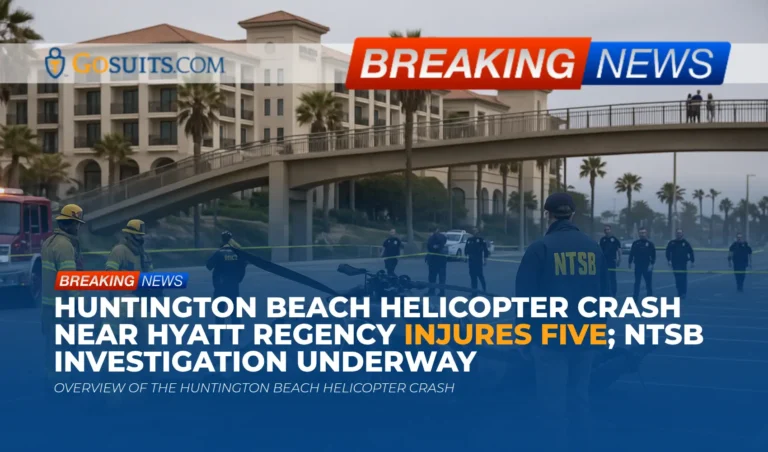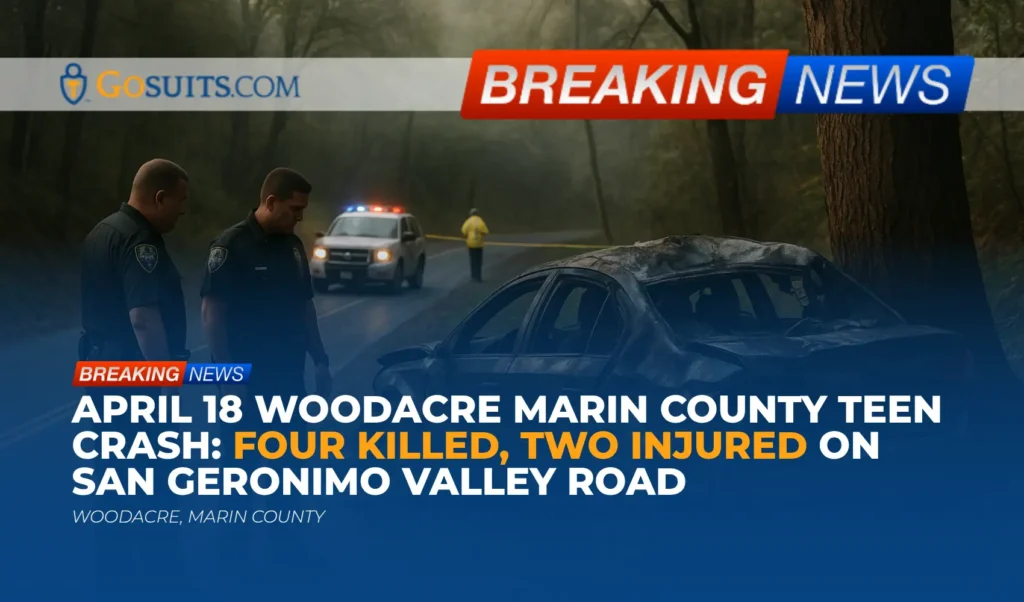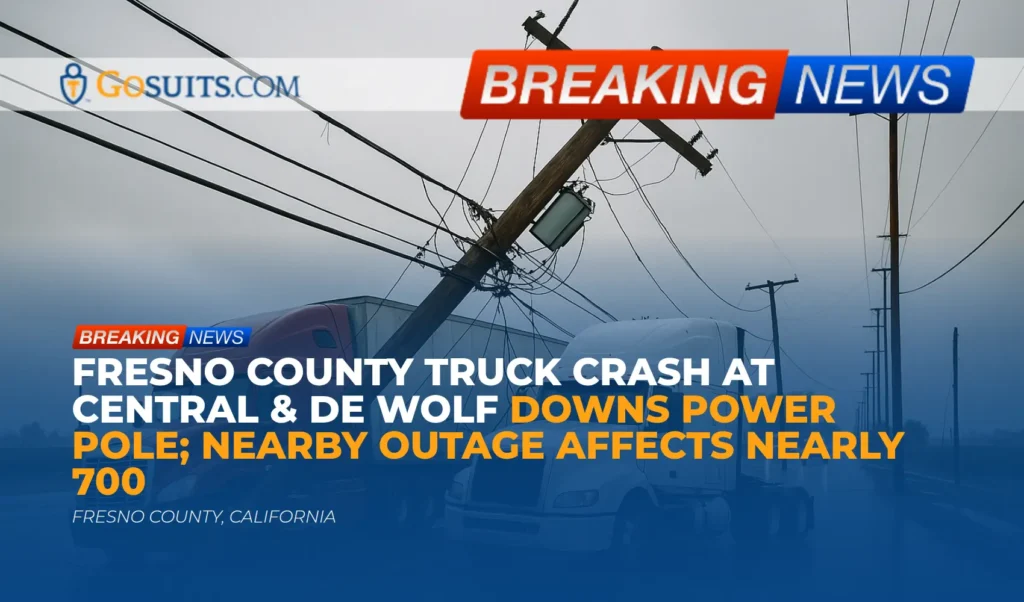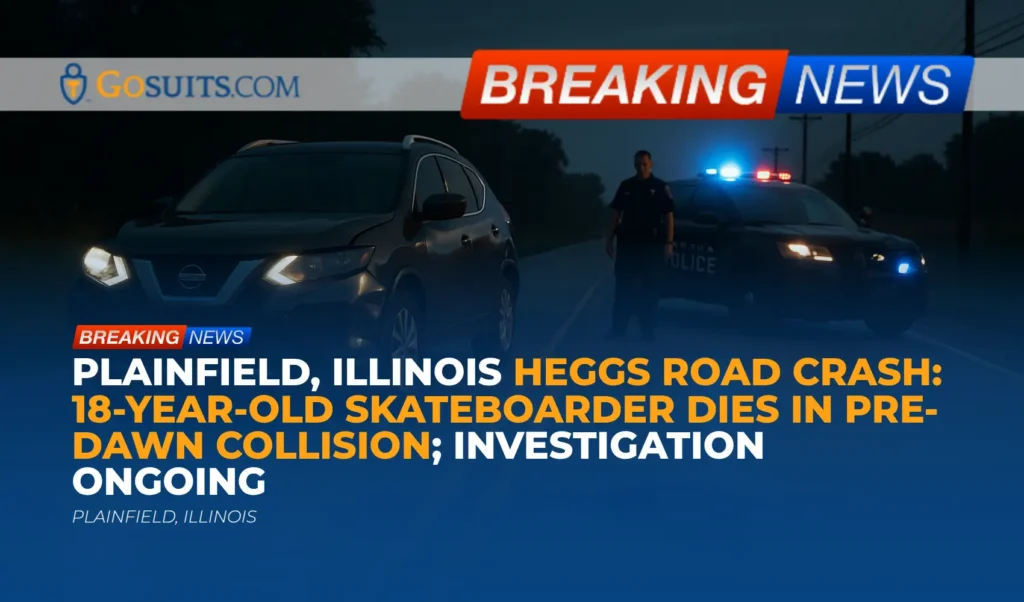- Overview of the Huntington Beach helicopter crash
- What we know so far: time, place, and initial reports
- Ongoing investigations and what they typically examine
- Reported injuries and immediate safety considerations
- Potential civil liability in helicopter crashes
- Multiple insurance layers that may apply
- Preserving evidence and documenting losses
- How to obtain key records and information
- Understanding government investigations (NTSB and FAA)
- Deadlines for California injury claims
- Practical steps after a helicopter incident
- Community safety reflections for events near crowded areas
- Commentary from Gosuits Huntington Beach, California Personal Injury Attorney
- Why timely action matters now
Overview of the Huntington Beach helicopter crash
A helicopter crashed near the beachfront in Huntington Beach, California, injuring five people on a busy weekend near the Hyatt Regency Huntington Beach Resort and Spa. According to publicly reported information, the crash happened around midafternoon as helicopters were arriving ahead of an oceanfront event featuring exotic cars and aircraft. Two people on board the helicopter and three individuals on the ground, including a child, were reported injured and transported to area hospitals. The National Transportation Safety Board (NTSB) opened an investigation, while Huntington Beach police and fire personnel secured the scene and assisted the injured.
This incident was deeply unsettling for families, hotel guests, event participants, and bystanders who witnessed a helicopter spinning and descending near a pedestrian bridge by Pacific Coast Highway. Early reports indicate the aircraft was a Bell 222 manufactured in 1980 that departed from Redlands Municipal Airport prior to the crash. At the time of writing, federal investigators and local authorities have not released final findings on cause.
What we know so far: time, place, and initial reports
Time and place
Initial reports place the crash at approximately 2:10 p.m. on a Saturday, in the beach parking area between Twin Dolphins Drive and Beach Boulevard, adjacent to the Hyatt Regency Huntington Beach Resort and Spa, along Pacific Coast Highway. The pedestrian bridge over PCH near the site reportedly closed following the crash as a safety measure.
Who was involved
Two individuals in the helicopter and three people on the ground, including a child, were reported injured. While media reports have discussed the pilot and described his social media presence, official agencies have not yet released a detailed injury report or a confirmed cause. We do not identify individuals by name here to respect privacy and because identity details are secondary to safety and recovery.
Context of the event
Helicopters were reportedly arriving in connection with a public event planned for the following day. Event organizers, aircraft owners/operators, and participating pilots typically coordinate arrivals and departures, working with local authorities and airport operations to manage safety and crowd proximity. The specifics of any event safety plan in this case are not yet publicly detailed by investigators.
Ongoing investigations and what they typically examine
In U.S. civil aviation accidents, the NTSB leads the investigation into probable cause, while the Federal Aviation Administration (FAA) addresses safety oversight issues. The NTSB’s process usually includes a preliminary report within weeks and a final report that can take many months. The NTSB outlines its process and timeframes here: NTSB Accident Investigation Process.
Investigators commonly examine:
- Aircraft condition and maintenance: Airworthiness, maintenance records, recent inspections, and any known mechanical issues.
- Pilot qualifications and recent experience: Certificates, ratings, medical status, training, and flight time profile.
- Flight operations and environment: Weather, visibility, winds, performance considerations, air traffic control communications, and operational decisions.
- Event logistics and safety planning: Landing zone controls, crowd management, and any coordination with local authorities for an event adjacent to populated areas.
- Witness accounts and video: Bystander video and statements often assist investigators in reconstructing sequence of events.
Under federal rules, certain aviation accidents must be reported immediately to the NTSB, and operators must preserve wreckage unless otherwise directed. See 49 CFR Part 830 for notification and reporting requirements.
Reported injuries and immediate safety considerations
Public reports indicate hospitalization for five people. When aircraft impact near crowds, injuries range from blunt force trauma to internal injuries and head wounds. Even when symptoms initially seem mild, the body’s stress response and delayed presentation can mask serious injuries. It is standard and appropriate for first responders to transport those involved for medical evaluation after an aviation crash.
In the days after an incident, those affected may encounter escalating medical needs: additional imaging, referrals to specialists, or post-concussive care. Keeping a careful record of symptoms, appointments, medications, and out-of-pocket costs can be important for insurance claims and potential civil actions.
Potential civil liability in helicopter crashes
Every aviation crash has its own facts. However, several categories of potential civil responsibility are commonly assessed in helicopter incidents that occur near public spaces:
- Pilot or operational negligence: Decisions on speed, altitude, approach path, and compliance with standard operating procedures may be examined against what a reasonably careful pilot would have done under similar conditions.
- Aircraft owner and operator responsibility: Owners/operators may have responsibilities related to aircraft airworthiness, maintenance, and oversight. Liability may attach even if a different individual was piloting, depending on the relationships and contracts in place.
- Maintenance providers: Improper maintenance or overlooked mechanical conditions can create product-like liability or negligence claims if proven to be a contributing factor.
- Manufacturers and component suppliers: Product defect claims may arise if a design or manufacturing defect or inadequate warnings contributed to the mishap.
- Event organizers and venue stakeholders: If landings occurred for a public event near crowds, questions can arise regarding site selection, safety perimeters, signage, crowd control, and coordination with authorities.
- Public entities: In limited circumstances, claims may involve public entities for unsafe conditions of public property or event permits. These cases trigger special claim procedures and strict deadlines in California, discussed below.
It is important to remember that the NTSB’s probable cause findings are not the same thing as civil liability, and civil cases may rely on broader evidence, including maintenance records, training policies, and coordination documents. While the NTSB’s final report is influential, courts apply civil standards of proof that can encompass more than the agency’s final causation language.
Multiple insurance layers that may apply
Helicopter incidents can involve several insurance policies:
- Aircraft liability and hull insurance: Typically carried by the owner/operator; may address bodily injury to third parties and property damage. Hull coverage addresses the aircraft itself.
- Pilot’s non-owned aircraft coverage: In some scenarios, pilots carry coverage for aircraft they do not own.
- Event liability insurance: Events sometimes procure general liability policies, which may include endorsements for aviation-related activities.
- Venue or hotel policies: Depending on contracts and facts, premises or operations coverages may be implicated.
- Medical payments and health insurance: MedPay or health insurance may initially cover treatment, with potential reimbursement (subrogation) later depending on recoveries from at-fault parties.
Insurance communications are critical. Before speaking with any insurance adjuster, it is prudent to consult a qualified attorney for a free consultation to understand rights and obligations. Statements made to insurers can be recorded and may be used to minimize or dispute claims later.
Preserving evidence and documenting losses
Evidence can disappear quickly after an aviation incident, especially in public areas near ocean winds, traffic, and cleanup operations. Sensible preservation and documentation steps include:
- Medical documentation: Obtain discharge summaries, imaging reports, and specialist notes. Keep a running log of symptoms and limitations as they evolve.
- Photographs and video: Preserve any photos or videos taken before, during, or after the crash, including images of the scene, debris, and injuries. Preserve original files with metadata.
- Witness information: Collect names and contact information for bystanders who saw the aircraft’s approach, spin, or impact.
- Expense records: Keep receipts for transportation, medications, medical devices, therapy, and any home care or childcare necessitated by injuries.
- Employment records: Save pay stubs, work schedules, and employer communications to document time missed and any impact on job duties.
Because NTSB rules control wreckage custody, private parties should not disturb physical evidence. Requests for access or inspection typically go through counsel working within established investigative frameworks. See the NTSB’s process overview: NTSB Accident Investigation Process.
How to obtain key records and information
Obtaining reliable documentation supports both understanding and recovery. The following government sources are commonly relevant in California aviation incidents:
Local police incident report
The City of Huntington Beach maintains public records, including incident reports, through its official portal. Requests are typically made under the California Public Records Act. Learn about public records rights through the California Department of Justice: California Public Records Act overview (DOJ). Huntington Beach provides public records services here: City of Huntington Beach Public Records.
Fire department and EMS records
Emergency medical services and fire response records may be available through the city, subject to privacy laws. A patient or authorized representative can usually request medical records. Federal guidance on access to medical records is provided by HHS: Right of Access to Health Information.

NTSB aviation docket and preliminary report
The NTSB publishes preliminary reports and final dockets for aircraft accidents. The searchable database is located here: NTSB Aviation Accident Database. Preliminary reports often appear within weeks, while final reports may take many months.
FAA aircraft information
For aircraft registration and related data, the FAA’s online registry can be searched by tail number: FAA Aircraft Registry Inquiry. FAA records can provide ownership, airworthiness, and registration status that may be relevant in civil claims.
Coroner’s office
In fatal incidents, the Orange County Sheriff-Coroner handles death investigations. Information about the Coroner Division is available here: Orange County Sheriff-Coroner, Coroner Division. For this Huntington Beach crash, public reporting indicates injuries but not fatalities at the time of writing; coroner involvement would be limited accordingly.
Understanding government investigations (NTSB and FAA)
The NTSB is an independent federal agency that determines probable cause of civil aviation accidents. The FAA oversees aviation safety regulations and may implement safety actions following an accident. Their roles are complementary but distinct.
Key points:
- Notification and reporting: Certain events must be reported immediately to the NTSB, and operators must submit written reports as required. See 49 CFR Part 830.
- Preliminary report: The NTSB often issues a brief preliminary report within weeks summarizing factual information gathered early on. See NTSB Investigation Process.
- Final report and docket: A comprehensive docket can include witness statements, maintenance records, and technical analyses. Final reports with probable cause may take many months to over a year.
While families and injured individuals may want immediate answers, federal investigations are methodical. Civil claims and insurance negotiations often proceed in parallel, using publicly released records as they become available, along with independent expert analysis retained by counsel.
Deadlines for California injury claims
California imposes strict time limits on civil claims:
- General personal injury: Two-year statute of limitations from the date of injury. See Cal. Code Civ. Proc. § 335.1.
- Claims against public entities: If a claim involves a California public entity, an administrative claim typically must be presented within six months of the incident for personal injury. See Gov. Code § 911.2. If rejected, a lawsuit deadline often runs six months from the date of rejection. See Gov. Code § 945.6.
Missing these deadlines can permanently bar recovery, regardless of the strength of the underlying facts. Because determining whether a public entity is involved can be complicated, getting prompt legal guidance is wise.
Practical steps after a helicopter incident
In the wake of a serious helicopter crash, it is understandable to feel overwhelmed. The following steps are practical, compassionate measures that support health, clarity, and rights:
- Prioritize medical care: Follow medical advice, attend follow-up appointments, and report any new or worsening symptoms promptly.
- Limit public statements: Avoid posting details or opinions about the incident on social media. Insurance companies and defense teams may monitor and use public statements against injured persons.
- Consult an attorney before speaking to insurers: Insurance adjusters may call quickly seeking statements. It is prudent to consult an attorney first for a free consultation to understand what to say and what not to say. Statements can be recorded and used later in claim evaluation.
- Preserve all evidence: Keep photos, videos, clothing worn, and any physical items related to the incident. Save medical bills and correspondence.
- Request official records: Initiate requests for police incident numbers and EMS records as appropriate. Use official government portals noted above for accuracy.
- Track financial impact: Maintain a spreadsheet or notebook detailing medical expenses, travel costs, lost time from work, and caregiving needs.
Community safety reflections for events near crowded areas
Events that bring aircraft close to public beaches and hotels create unique safety challenges. Coordinated planning, clear perimeters, and conservative operation standards are essential to protect families, spectators, and hotel guests. A few community-focused reflections:
- Landing zone management: Adequate buffer zones and crowd control reduce the risk that a loss of control will impact bystanders.
- Approach and departure corridors: Selecting paths that minimize overflight of dense pedestrian areas can reduce harm if an emergency occurs.
- Public communication: Clearly marked areas, signage, and real-time updates help keep people out of active operation zones.
- Coordination with local agencies: Close collaboration with police, fire, and city officials supports safe operations and emergency response readiness.
While aviation events can inspire and educate, safety must be the guiding priority, particularly along crowded coastal corridors like Pacific Coast Highway.
Commentary from Gosuits Huntington Beach, California Personal Injury Attorney
Our hearts are with everyone hurt in this Huntington Beach crash, and with the families who spent an anxious weekend at the coast. This article is for general information and education, and it is not a substitute for individualized legal counsel about any particular situation.
Based on the publicly reported facts, several layers of responsibility may be evaluated, including pilot decisions, maintenance history, aircraft condition, and how event operations were managed adjacent to busy public areas. When aircraft operate near crowds, even a momentary loss of control can have life-altering consequences for bystanders with no warning or opportunity to protect themselves. Determining the full picture requires careful review of NTSB materials, maintenance documentation, and event planning records.
In our experience, insurance companies and corporate defendants move quickly to shape the narrative after high-profile incidents. Adjusters may reach out early, frame questions in ways that seem routine, and collect statements that later surface as reasons to limit compensation. Corporations and insurers understand the complexity of aviation claims and may rely on that complexity to delay, dispute, or diminish legitimate losses. Having a seasoned advocate levels the playing field, ensures critical evidence is preserved, and helps navigate specialized issues like multiple policies, subrogation, and coordination with federal investigations.
A free consultation can clarify rights, deadlines, and next steps without any commitment. It helps people understand how to handle insurance communications, what records to request, how to document injuries, and which timelines apply, particularly if public entities or event permits are part of the picture. Speaking with counsel before engaging with insurers can prevent common pitfalls and protect long-term interests.
Why timely action matters now
What to do
- Seek and follow medical care: Continue treatment and collect all medical records, imaging, and bills related to the incident.
- Secure official records: Obtain the police incident number and request records through the city’s public records portal; track EMS and hospital documentation.
- Preserve evidence: Save photos, videos, witness contacts, clothing, and damaged personal items. Keep originals with metadata when possible.
- Consult an attorney before speaking to insurers: Get a free consultation to understand your rights and how to handle calls from adjusters.
- Document losses: Maintain a running log of symptoms, missed work, caregiving needs, travel costs, and other out-of-pocket expenses.

Why acting now matters
- Evidence can disappear: Scenes are cleaned up quickly, memories fade, and witnesses disperse. Early steps preserve proof needed to establish what happened.
- Deadlines are strict: California law imposes a two-year deadline for most injury claims, and only six months to present claims involving public entities. Delays risk losing rights under CCP § 335.1 and Gov. Code § 911.2.
- Insurers move fast: Adjusters often contact people early. Speaking without guidance can affect future claims. A brief consultation helps avoid missteps.
- Medical continuity supports recovery: Consistent care and documentation both improve health outcomes and create a clear record of injury progression.
When and where it matters
- Immediately and locally: Start with nearby medical providers, the City of Huntington Beach records portal, and your treating physicians’ records departments.
- As the NTSB releases updates: Monitor federal updates via the NTSB database to align private evidence with official findings.
- Before insurer statements: Arrange a free consultation to understand how to approach recorded statements or medical authorizations safely.
Context
Aviation incidents are complex, particularly in public spaces where multiple parties and policies intersect. Early, informed action preserves options, clarifies responsibilities, and helps ensure that those harmed are not disadvantaged by procedural hurdles or insurance tactics. The goal is simple: protect health, preserve truth, and respect the timelines that the law and the investigative process require.






